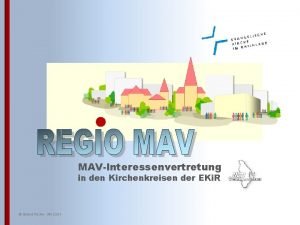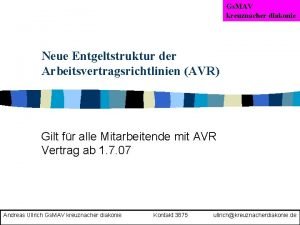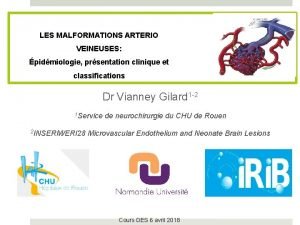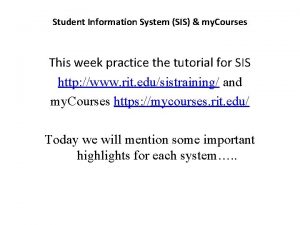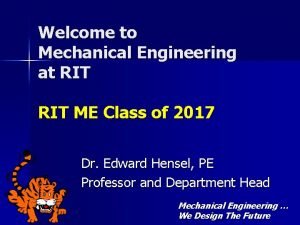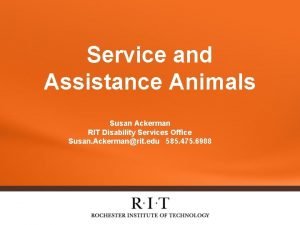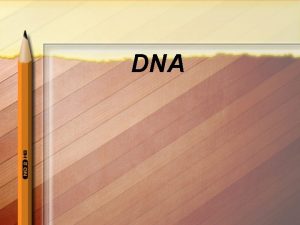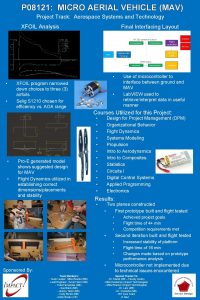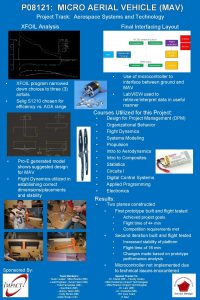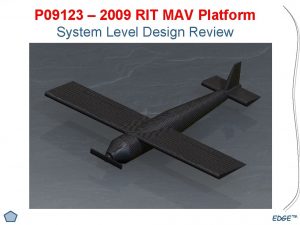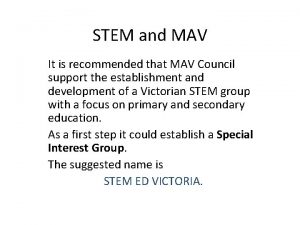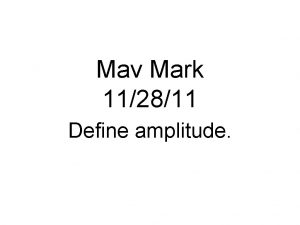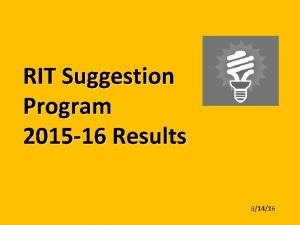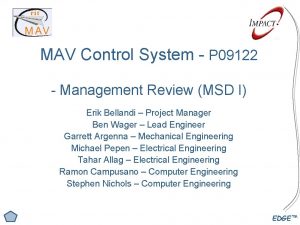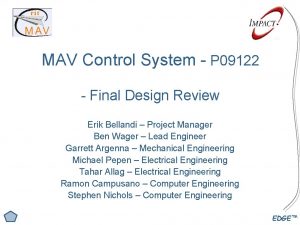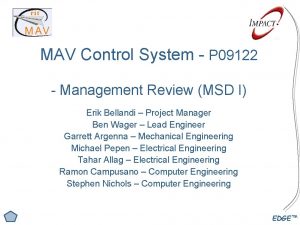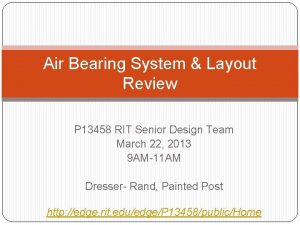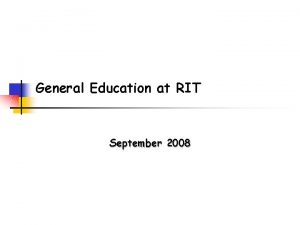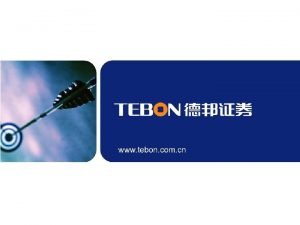2007 2008 RIT MAV System Review P 08121




















- Slides: 20

2007 -2008 RIT MAV System Review (P 08121) Dr. Jeffrey Kozak – Faculty Guide Michael Reeder – Team Leader Kevin Hand – Lead Engineer Todd Fernandez – ME Susan Bieck – ME Jeremy Teets – ME Cody Rorick – ME …where the sky is only the Adam Bosen – CE beginning… …and the ground is likely the Sponsored By:

Re-Introduction of Team Members Sue Bieck Mike Reeder Kevin Hand Jeremy Teets Todd Fernandez Adam Bosen Cody Rorick

Project Description/Customer Needs n Primary Objective: ¡ ¡ Create a Micro Aerial Vehicle, expandable in nature for future RIT research Simple, robust and stable in design Capable of reading back information regarding the vehicle’s speed, angle of attack, pitch, yaw and roll rates Flight Dynamics competition (held internationally) establishes target specifications (engineering metrics) n n Max linear dimension is 80 cm Max weight is 1 kg Required flight time is 4 minutes Secondary Objective: ¡ Compete in international Flight Dynamics competition

Objective of 2007 -2008 RIT MAV n n n n n Platform design decided upon Engineering metrics/product specifications completed List of components and materials compiled 3 -D CAD model of plane created (XFOIL, Pro-E, etc. ) Foam model built based on concept generations Experiments designed to test components’ proper functionality Components ordered/in team’s possession Components in possession are in test process Foam plane is built and glide tested

Objective of 2007 -2008 RIT MAV

Selected Concept

Selected Concept – Airfoil n Selig S 1210 airfoil chosen for: ¡ ¡ ¡ Weight range (500 -1000 g) Efficiency at various AOA’s Speed range (15 mph+)

Selected Concept – Propulsion System n Esskay 400 XT ¡ ¡ n 1. 5 oz brushless motor Allows for several prop sizes to achieve various speeds Thunder Power TP 9103 ¡ ¡ 3 cell configuration 910 m. Ah **Several props will be bought and tested to determine optimal speed of the MAV**

Selected Concept – MAV Design n MAV design based on: ¡ ¡ ¡ n Brainstorming sessions Feasibility analyses Flight dynamics calculations (reference) Chosen design utilizes ¡ ¡ ¡ Stream-lined cylindrical fuselage Fuselage designed to incorporate airfoil into body Symmetrical rear airfoil

Selected Concept – Flight Dynamics n n Flight dynamics calculations led to a series of calculations to determine stability of aircraft Calculations also aided in determining proper rear tail dimensions ¡ ¡ Horizontal tail span – 10 in Vertical tail span – 5 in Horizontal & vertical tail chord – 4 in Moment arm of the tail – 17 in

Selected Concept – CAD Generated Model

Selected Concept - Controls n Main component to be used is O-Navi microcontroller ¡ ¡ ¡ n n Contains angular accelerometer, GPS, among others Use of microcontroller will enable complex information to be sent to and received from MAV Paparazzi considered for software architecture Pressure transducers (velocity, AOA) Servos (flight control)

Selected Concept – Design of Experiments n n Differential pressure sensor used in conjunction with a pitot tube to determine aircraft velocity One differential pressure sensor on each wing to determine pressure difference which will yield AOA experimentally Angular/Linear accelerometers used to determine pitch, roll and yaw of aircraft during flight Lab. VIEW, Lab. VIEW!!!

Selected Concept – User Interface n Utilize Lab. VIEW to create interface: ¡ ¡ ¡ n Altitude Velocity Pitch Roll Yaw Example shown

Risk Assessment

Tentative Bill of Materials (BOM) n n Tentative BOM is shown to the right Impact Technologies has generously donated $1, 500. 00 to the MAV Senior Design effort for 2008.

Completed Objectives – MSD I n n n n Platform design decided upon – COMPLETED Engineering metrics/product specifications completed – COMPLETED List of components and materials compiled – COMPLETED 3 -D CAD model of plane created (XFOIL, Pro-E, etc. ) – COMPLETED Foam model built based on concept generations – COMPLETED (1 st run model) Experiments designed to test components’ proper functionality – WIP Components ordered/in team’s possession – WIP Components in possession are in test process – WIP

Tentative Schedule for MSD II - Completion of blank plane (red) - Component testing (yellow) - System integration of components (orange) - Integration of system into ground model (green) - Flight tests (light blue and blue) - Base station data retrieval (purple) - MAV system integration (light green) - Completed project flight testing (gray)

Remember…

Q&A
 2008 2008
2008 2008 Juan herrera y mav video porno
Juan herrera y mav video porno Gesa mav ekir
Gesa mav ekir Mav
Mav Mavprint mnsu
Mavprint mnsu Mav local government
Mav local government Classification spetzler martin mav
Classification spetzler martin mav Trading mav
Trading mav Uta mav orgs
Uta mav orgs Rit faculty sis
Rit faculty sis 2007 office system
2007 office system Chapter review motion part a vocabulary review answer key
Chapter review motion part a vocabulary review answer key Ap gov final review
Ap gov final review Nader amin-salehi
Nader amin-salehi Traditional and systematic review venn diagram
Traditional and systematic review venn diagram Narrative review vs systematic review
Narrative review vs systematic review Rit withdraw from class
Rit withdraw from class Rit mechanical engineering
Rit mechanical engineering Manny contomanolis
Manny contomanolis Rit emotional support animal
Rit emotional support animal Rit srate
Rit srate


